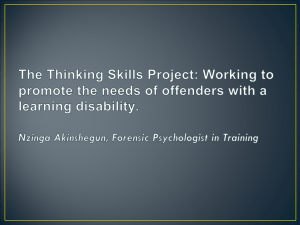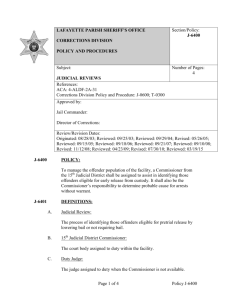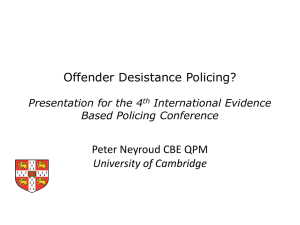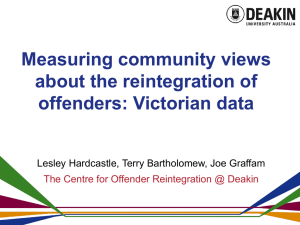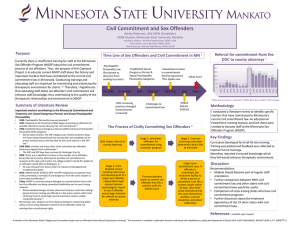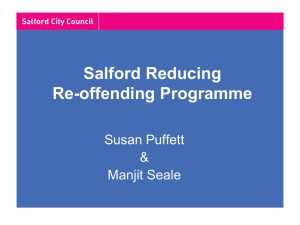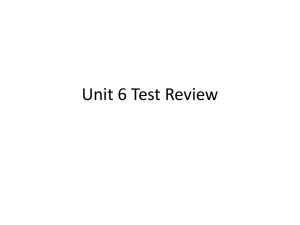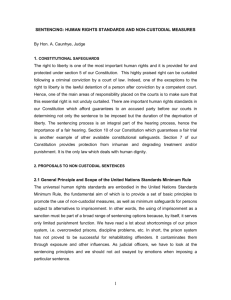Dr Max Lowenstein Presentation Slides
advertisement
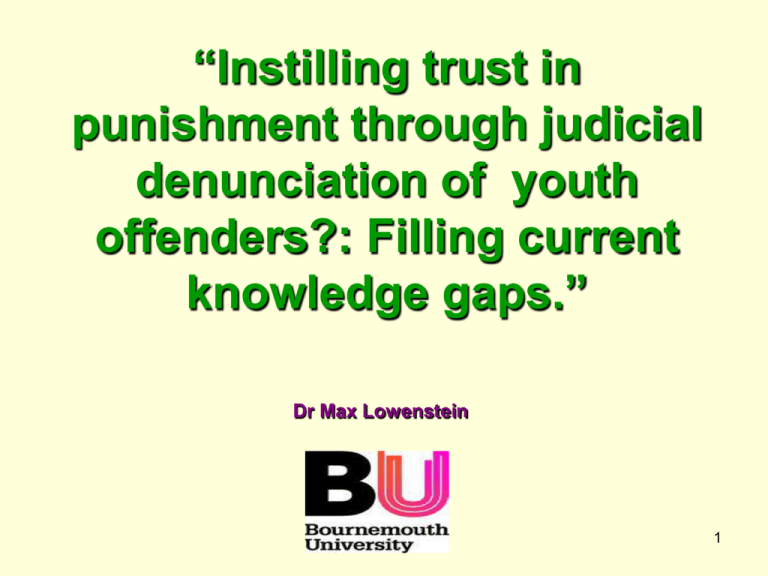
“Instilling trust in punishment through judicial denunciation of youth offenders?: Filling current knowledge gaps.” Dr Max Lowenstein 1 Meaning of Judicial Denunciation? • Durkheim, E. (1984): 63 punishment means ‘maintaining inviolate the cohesion of society by sustaining the common consciousness in all it’s vigour.’ • When judges communicate with society about wrong doing to preserve law and order, ‘it is essential that punishment inflicted for grave crimes should adequately reflect the revulsion felt by the great majority of citizens for them,’ Denning, A.T. (1949) 2 Meaning of Judicial Denunciation? • Walker, N. (1983): vii Denunciation recognises the value of both individual culpability and preserving community bonds, thus ‘denouncers are really either quasiretributivists or crypto-consequentialists’ • Lawrence, F. (1999): 6 ‘Expressive theory may be concerned less with providing a full justification of punishment than with understanding the full impact of punishment’ 3 Meaning of Judicial Denunciation? • Promotion of societal cohesion by accurately reflecting the perceptions of the ‘law abiding majority of citizens’ Rychlak, R. (1990) • The ‘collective morality’ of society Maruna, S. (2011): 7 • Re-education that can engage/change the offender and address media distortion appears to be important Lowenstein, M 4 (2013): 32-33 Meaning of Judicial Denunciation? • Positive side – The positive promotion of self awareness and reintegration through a ‘mutual effort at reconciliation, where offender and society work together to make amends’ Johnson, (2002): 328 • Negative side – The negative rejection of individual offender immorality and wider social ignorance as a judicial attempt at ‘status degradation’ Garfinkel, (1956): 420 5 Judicial Principles and Approach towards Youth Offenders • 19th C Protection/Early Intervention Industrial School Acts (1857-80) & Youthful Offenders Act (1854) ‘children in trouble’ & ‘showing kindness to nip crime in the bud’ Harris & Webb (1987): 15 • Child welfare S. 44 Children & Young Persons Act(1933) • Offending can be relevant evidence of harm due to unreasonable parental controlS.31(2) Children Act(1989) • Prevent (re) offending S. 37 Crime & Disorder Act (1998) • S. 142A (3) Criminal Justice Act (2003) 4 youth sentencing principles mirror their adult counterparts except for deterrence which is omitted S. 142(1)(b) ‘the reduction of crime (including its reduction by deterrence)’ 6 • Principle aim is to prevent (re) offending S. 142A (2)(a) Judicial Principles and Approach towards Youth Offenders • Offence harm and offender culpability (Sentencing Guidelines Council, Seriousness Guideline, 2004). • Prevention of offending and detailed regard to offender welfare (Sentencing Guidelines Council, Sentencing Youths Guideline, 2009): para. 2.9 with the judicial duty to comply with definitive guidelines supported by S. 125 Coroners & Justice 7 Act (2009) Youth Sentencing Statistical Trend Limits • Recorded crime peak 2006, but since decreasing levels 2007-10. (National Audit Office, 2010) : 12 • Between 1992-97 = 40% custody increase then decline 2001-03 with the10-14 age group increasing (Audit Commission 2004): 34-6 • Youth offender age, gender, ethnicity (MOJ, Youth offences resulting in a disposal by region, 2010/11). • Violence against the person (malicious wounding) most currently, BUT Theft & Handling , Criminal Damage/Public Order offenders numbers interchange for highest volume - 2002-11(MOJ Statistics, Offence classification numbers used for court proceedings, 8 2011 (YJB/MOJ Statistics Bulletin, 2011): Chart 2.6 Judicial Principles and Approach towards Youth Offenders • Childhood risk/disadvantage, (Berman 2011: 16) • Youth Maturity/Education level matters, (Weijers, 2002: 139-42), (Sentencing Guidelines Council, Sentencing Youths Guideline, 2009): para. 3.1 • Diversion approach - S 37 ‘prevention’ Crime & Disorder Act (1998) S 65(4) – police warn rather than reprimand depending on offence seriousness. S 66 – YOT referral • Grave offender? Dangerous offender? 9 Judicial Principles and Approach towards Youth Offenders • DTO most common sentence, but downward trend for custody overall. (Allen 2011): fig.1 • The test to be applied for 12 – 14 year old persistent offenders and 15 – 17 year olds: ‘Is the offence of such gravity that a sentence substantially beyond the two year maximum for a DTO is a realistic possibility?* Beyond 2 yrs Dangerous & Grave Crime = Crown Court (JSB Youth Court Bench Book, 2013): 29, 32-36 10 Judicial Principles and Approach towards Youth Offenders • Dangerousness cusp = If the child or young person was found guilty, would there be a significant risk of serious harm to the public from them committing further similar offences and would a sentence of four years detention be appropriate for this offence? (JSB Youth Court Bench Book, 2013): 38 • Custody cusp = 1) where DTO is last resort as YRO/Fine not justifiable 2) where there are no applicable offence specific guideline(s), ‘the court must look to the sentence that may have been appropriate for an adult offender convicted of the same matter,’ (JSB Youth Court Bench Book, 2013): 81 11 Judicial Principles and Approach in case law • DTO regional variations? – ‘post code lottery for youth custodial sentences’, (Muncie, 2011): 52 • DTO application – persistent offender? • DTO application – substantially beyond 2 yr maximum? • DTO application – ABH with other offences? 12 Next Steps… • Gathering qualitative perceptions on meaning (what principles) and application (how and judicial trust/faith in impact on offender, victim, society) from judges seems important as ONLY they sentence. To what extent will judicial perceptions regarding the impact of youth denunciation be positive/negative, similar/different? To what extent will the approach to construct sentencing remarks reflect youth justice principles? • Offence + Court areas supported by Methodology/Ethics and JO permission. • Expanding this qualitative research in the future to look at YOT’s who more closely monitor offenders and can help our understanding of the impact of denunciation 13 outside of court. THANK YOU FOR LISTENING! QUESTIONS AND YOUR VIEWS. 14

